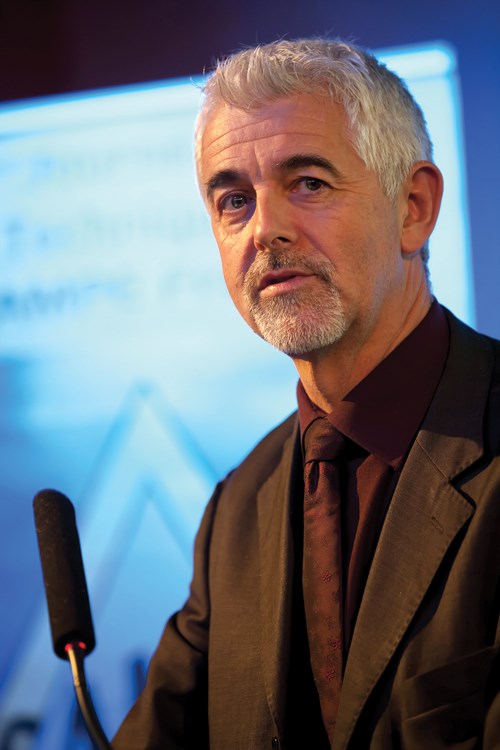Looking ahead to next-gen aerostructures
CompositesWorld's conferences director Scott Stephenson reviews Airbus veteran Bruno Beral’s views of composites use on coming commercial aircraft platforms.
Although the Airbus A350 XWB and the Boeing 787 are new to the commercial aircraft market, the design and material choices for these planes are, by comparison, relatively old and very much a settled matter. And even if the first A350 XWB has yet to fly, it’s not too soon to start thinking and wondering about the material and functionality demands of the next generation of commercial aircraft. More importantly, it’s not too soon to wonder what role composites might play in those craft.
Bruno Beral, head of structure policy and development at Airbus SAS (Toulouse, France), was asked to look into the Airbus future with this question in mind. He spoke on that subject at CompositesWorld’s 2011 Carbon Fiber conference, held in December, in Washington, D.C.
Beral began with a review of composites use throughout the Airbus family, dating back to the A300 aircraft in the early 1970s. This plane was less than 5 percent composites by weight, but it proved to be just the starting point for increased composites use in successive aircraft, including the A320, A340, A380 and, now, the A350 XWB, which is 52 percent composites.
Although the Boeing 787 and the A350 are of similar size and shape, many of the notable composite features of the Airbus craft differ significantly from those of the 787. Beral reported that, in contrast to the Boeing 787’s full-barrel tapewound fuselage, the Airbus design is manufactured in four sections; each section features four independently manufactured curved panels, made with carbon fiber prepreg tapes and integrated stringers, which are subsequently assembled to form the barrel section. The longest fuselage panel section is 18m/59 ft long. Further, he reported, the use of a composite wing on the A350 saved 2.5 metric tonnes (5,512 lb) as compared to a metallic design.
Looking to the future, one thing Beral made clear is that, although carbon fiber made great strides on the A350, Airbus is being careful not to place all of its material eggs in either the composites or the metals basket. He emphasized that “no single material can do it all,” noting that Airbus likes to encourage competition between composites and metals, believing that such competition is healthy and produces the best aeroproducts. For that reason, all options are on the table.
That said, Beral and Airbus have specific goals and ideas driving the design and engineering of its next-generation commercial aircraft. This is fueled at least in part by a European organization called ACARE (Advisory Council for Aeronautics Research in Europe), which has set a goal of reducing carbon dioxide emissions from aircraft by 50 percent. Airbus is also driven, of course, by the needs — and demands — of its customers. Beral broke these needs into three categories: flying economically and efficiently (reduced fuel use, increased plane uptime, reduced maintenance costs); flying green (reduced emissions, reduced noise); and flying simple (simplified aircraft operation and maintenance procedures).
This futuristic vision also includes advances in airframe technology. Beral identified several opportunities here:
• New fiber and matrix products.
• Fastener-free composite joining materials.
• Increased automation of composites manufacturing.
• Material morphing technology.
• Self-deicing materials.
• Advanced light and hard metallic alloys.
• Smart and multifunctional structures.
• Self-healing and self-repairing structures.
• Alternate fuel systems (fuel cells and all-electric power plants).
• Open-rotor engine configuration.
If all of these technologies were to come to fruition, it is possible that Airbus could realize its commercial aircraft ideal, the attributes of which Beral also included, somewhat tongue-in-cheek: extremely light weight, self-adaptive geometry, non-fossil-regenerated fuel, clean combustion products, inaudible engine and almost 100 percent recyclability/reusability
Related Content
Next-generation airship design enabled by modern composites
LTA Research’s proof-of-concept Pathfinder 1 modernizes a fully rigid airship design with a largely carbon fiber composite frame. R&D has already begun on higher volume, more automated manufacturing for the future.
Read MorePlant tour: Albany Engineered Composites, Rochester, N.H., U.S.
Efficient, high-quality, well-controlled composites manufacturing at volume is the mantra for this 3D weaving specialist.
Read MoreA new era for ceramic matrix composites
CMC is expanding, with new fiber production in Europe, faster processes and higher temperature materials enabling applications for industry, hypersonics and New Space.
Read MoreCryo-compressed hydrogen, the best solution for storage and refueling stations?
Cryomotive’s CRYOGAS solution claims the highest storage density, lowest refueling cost and widest operating range without H2 losses while using one-fifth the carbon fiber required in compressed gas tanks.
Read MoreRead Next
“Structured air” TPS safeguards composite structures
Powered by an 85% air/15% pure polyimide aerogel, Blueshift’s novel material system protects structures during transient thermal events from -200°C to beyond 2400°C for rockets, battery boxes and more.
Read MoreDeveloping bonded composite repair for ships, offshore units
Bureau Veritas and industry partners issue guidelines and pave the way for certification via StrengthBond Offshore project.
Read MorePlant tour: Daher Shap’in TechCenter and composites production plant, Saint-Aignan-de-Grandlieu, France
Co-located R&D and production advance OOA thermosets, thermoplastics, welding, recycling and digital technologies for faster processing and certification of lighter, more sustainable composites.
Read More
























